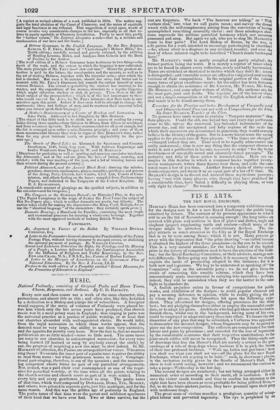M US IC.
National Psalmody ; consisting of Original Psalm and Hymn Tunes, Chants, Responses, and Anthems. By C. 1). llacKETT.
Every now and then comes out a work of the same character, size, pretensions, and almost title as this ; and often also, like this, heralded by a dedication to a Bishop and a large list of subscribers. A foreigner would suppose, if the array of volumes of Psalmody were placed be- fore him which only the last seven years have produced, that church music was in a most pahuy state in Englund; that singing in parts was the universal practice as a portion of public worship, or at least that our churches abounded with well-appointed choirs. He would infer, from the rapid succession in which these works appear, that the demand must be very large, the ability to use them very extensive, and the appetite for novelty very keen. Now the fact is, that no musical publications are so little needed—none so little used. The same tunes are sung in our churches in uninterrupted succession ; for every tune being learned (if learned or sung by anybody except the clerk) by ear, the progress of acquiring a new one most be slow indeed. In Mr. Hactiorr's Collection, the Psalms are arranged for four voices. Who are to sing them ? To sustain the inner part of a psalm tune requires the ability to read from notes : but what gentleman learns to sing ? Congrega- tional part-singing, therefore, is out of the question ; and the maintain- ing competent choirs forms no part of our parochial arrangements. Nor, indeed, was a paid choir ever contemplated as one of the requi- sites for parochial worship, at the time wheu all the points relating to the church service and church music as part of' it were settled. Then every lady and every gentleman learned to sing. The psalm tunes of that time, which were composed by DowitAxn, BYRD, TYE, Moulxv, and others, were printed in separate parts, just like madrigals, and for the same reason. And this was the golden age of' psalmody in England. The psalm tunes of that time were the purest and sublimest specimens of their kind that we have ever had. Two or three survive, but the rest are forgotten. We hack " The heavens are telling," or " With verdure clad," into what we call psalm tunes ; and survey the dismal wreck with the self-complacency arising from the conviction of having accomplished something unusually clever : and these misshapen abor- tions supersede the sublime parochial harmony which our ancestors possessed and sang. But again we ask, who are to sing Mr. Haciuvris tunes in four parts ? The Lord Bishop of Ripox, by the way, is a fit patron for a work intended to encourage part-singing in churches! —he, whose choir is a disgrace to any civilized country, and over the door of whose Minster ought to be inscribed "Church music burlesqued here!"
Mr. II.s.cr.vres work is partly compiled and partly original; the former portion being the worst. It is merely a reprint of tunes which are to be found in ahnost every collection, newly and badly harmonized. Tunes are stretched or shortened to metres which they don't fit ; accent is disregarded ; and venerable names are affixed to vulgarized and tawdry versions of their compositions. In the original portion of the volume many tunes of great excellence occur ; for the editor has been fortunate enough to obtain the assistance of Dr. CROTCH, Mr. TunLE, Mr. Goss, Mr. HoesLov, and some other writers of ability. His anthems are, for the most part, poor and feeble. The repel its are of the lowest class; and not a single composition at all worthy the English school of cathe- dral music is to be found among. them.
Exercises fur the Pritet ice and heller Development of Unequally 'noted and Obscurely-timed l'ass.t!les met with in Compositions jiw the Rite, By Jolts 13aAnim, Teacher of' the Flute. No persons have more reason to exclaim " Tempora mutantur" than flute-players. Could the old, one-keyed box and ivory-tipt perffirmers come to life, survey the rosewood, key-beloaded iustruments of the present day, and the unexplored and lofty regions of the scale into which their successors are accustomed to penetrate, they would scarcely believe in the identity of the genus. But in a more literal sense the saying applies to the present race of ilute-players. " The times are changed" —changed indeed they are. Time used to be equally admeasured and easily understood ; time is now any thing that the composer chooses to make it, and a publication is become necessary in order "for the better development of unequally-noted and obseurely-timed passages." The pedantry and folly of these antics is inconceivable. Here are ex- amples in this treatise in which a composer hooks together twenty. seven semiquavers, writes those figures over them, and calls the cate. noted mass a bar of 12-4 time. Another forms a chain of thirty-sevca demisemiquavers, and treats it as an equal part of a bar of C time. Mr. 13nalosst's design is to dissect and unravel these mysterious passages ; havi n g " net with many players, who, though they have practised for a considerable time, have founti a difficulty in playing them, or were only right by chance." No wonder.


























 Previous page
Previous page